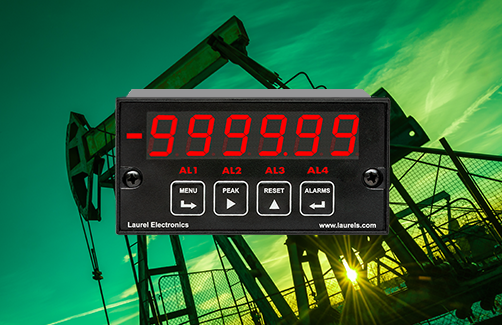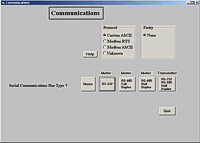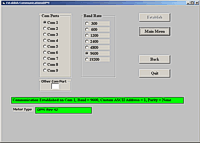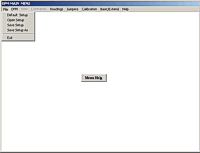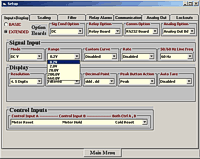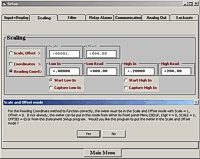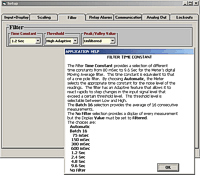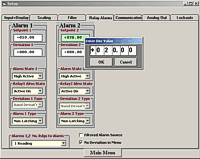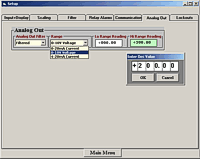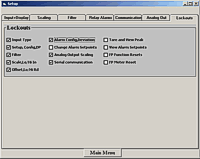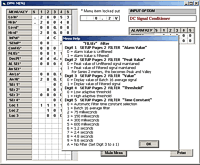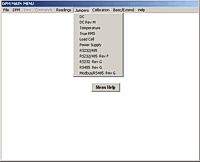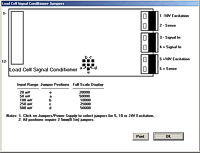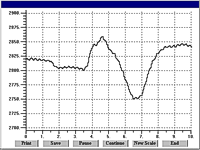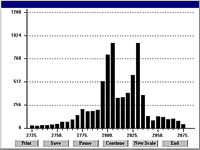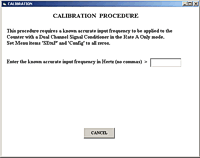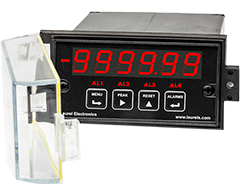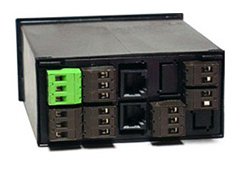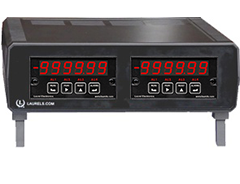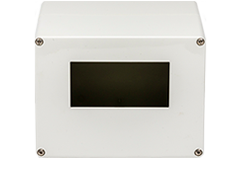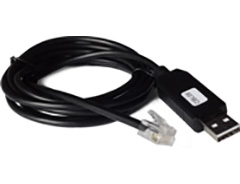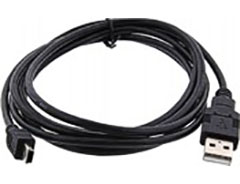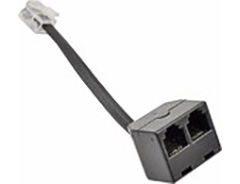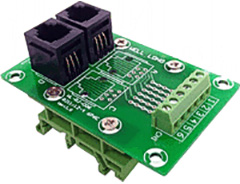Features
- Displays Duty Cycle with resolution of 1% , 0.1% or 0.01% .
- Displays Pulse Width Modulation (PWM) in engineering units
- Frequencies from 0.005 Hz to 10 kHz.
- Inputs from NPN or PNP proximity switches, contact closures, digital logic, magnetic pickups down to 12 mV, or AC inputs up to 250 Vac.
- Takes ratio of ON or OFF period and total period.
- Triggers on positive or negative pulse edges.
- Digital span adjust from 0 to ±999,999, zero adjust from -999,999 to +999,999
- Front panel scalable: to ±999,999 for use with current shunts
- 1/8 DIN size with bright red or green 0.56" (14.2mm), high LED digits
- Transducer excitation output, 5, 10, 12, or 24 Vdc (isolated)
- Power 85-264 Vac / 90-300 Vdc or 10-48 Vdc / 12-32 Vac (isolated)
- Operating temperature from -40°C to 70°C (-40°F to 158°F)
- Wide choice of Plug-in-Play options:
- 2 or 4 relays, mechanical or solid state, for alarm or control (isolated)
- 1 or 2 Analog output, 4-20 mA, 0-20 mA, 0-10V, or -10V to +10V (isolated)
- Communications: Ethernet, WiFi, USB, RS232, RS485 (isolated)
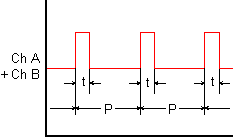
The Laureate™ 1/8 DIN Digital Panel Meter for duty cycle
is a measure of ON or OFF period as a percentage of total period. Duty cycle is determined by averaging an integral number of periods over a gate time which is selectable from 10 ms to 199.99 s. The same signal is applied to Channels A and B. The meter divides the average pulse width t by the period P between pulses and expresses the ratio t/P in percent. A resolution of 1%, 0.1% or 0.01% is selectable. By selecting leading or falling pulse edges, ON or OFF duty cycle can be displayed.Pulse Width Modulation (PWM) is a transducer output format where the measured information is provided as duty cycle applied to a constant frequency, such as 120 Hz. As for duty cycle, the meter divides the average pulse width by the period between pulses over a gate time which is selectable from 10 ms to 199.99 s. It then scales this ratio mathematically to display this ratio in engineering units, such as relative humidity (RH).
The Laureate duty cycle & pulse width modulation meter uses an Extended counter main board and the FR dual-channel signal conditioner board, which accepts signals from 12 mV to 250 Vac, inputs from proximity switches with a PNP or NPN output, TTL or CMOS logic, and contact closures. Jumper selections provide optimum operation for different sensor types and noise conditions. A built-in (isolated) 5, 10, 12, or 24 Vdc excitation supply can power proximity switches and other sensors.
Laureate Digital Panel Meters are easily programmed with Laurel’s free Instrument Setup Software, downloadable from our website and compatible with Windows PCs, requiring a data interface board for setup.
All signal conditioner board ranges are factory-calibrated, with calibration factors for each range securely stored in an onboard EEPROM. These factors can be scaled via software to accommodate external shunts, enabling field replacement of signal conditioner boards without necessitating recalibration of the associated digital panel meter. For optimal accuracy, factory recalibration is recommended annually. All Laurel Electronics instruments undergo factory calibration using the industry-leading Fluke calibrators, which are recalibrated yearly and certified traceable to national standards, ensuring the highest level of precision and reliability.
- An unfiltered selection provides true peak and valley readings and aids in control applications.
- A batch average filter selection averages each 16 conversions.
- An adaptive moving average filter selection provides a choice of 8 time constants from 80 ms to 9.6 seconds. When a significant change in signal level occurs, the filter adapts by briefly switching to the shortest time to follow the change, then reverts back to its selected time constant. An Auto setting selects the time constant selection based on signal noise.
Peak and valley values are automatically captured. These may be displayed via a front panel pushbutton command or control signal at the rear connector, or be transmitted as serial data.
Two rear panel control Inputs (CMOS/TTL levels, logic 0 = tied to digital ground, logic 1 = open) or dry contacts that can be set to control / activate 14 meter commands.
An (isolated) 5, 10, 12, or 24 Vdc excitation output is standard to power transducers or two-wire transmitters. Ratiometric operation, which automatically compensates for changes in the applied excitation, is jumper selectable for applications, such as bridges, where the signal to be measured is proportional to the excitation level.
Modular Design for Maximum Flexibility at Minimum Cost
All boards are isolated from meter and power grounds. Optional Plug-in-Play boards for communications and control include Ethernet, WiFi, serial communication boards, dual or quad relay boards, and an analog output board. Laureates may be powered from 85-264 Vac or optionally from 12-32 Vac or 10-48 Vdc. The display is available with bright red or green 0.56" (14.2mm) high LED digits. The 1/8 DIN case meets NEMA 4X (IP65) specifications from the front when panel mounted. Any setup functions and front panel keys can be locked out for simplified usage and security. A built-in 5, 10, 12, or 24 Vdc excitation supply can power transducers, eliminating the need for an external power supply. All power and signal connections are via UL / VDE / CSA rated screw clamp plugs.
The Laureate™ Series features modular design with up to 7 isolated plug-in boards, applicable to all Laureate 1/8 DIN Digital Panel Meters.

Modular Hardware
The design of the Laureate™ Series is modular for maximum flexibility at minimum cost. All boards are isolated from meter and power grounds. The base configuration for a panel meter or counter consists of a main module (with computer and plug-in display boards), a power supply board, and a signal conditioner board. Optional plug-in-play boards include an isolated setpoint controller board, an isolated analog output board, and an isolated digital interface board. Modular design and a choice of plug-in options allow the Laureate to be customized for a broad range of applications from simple monitoring to control and computer interface. There can be up to five plug-in boards in a 1/8 DIN Laureate.

Connecting Laureate Digital Panel Meters to a Local Area Network (LAN)
Up to 30 Laureate Digital Panel Meters and/or LT Transmitters can be configured for RS485 and daisy-chained to an LT Transmitter using Laurel’s High Speed Ethernet-to-RS485 converter board for seamless LAN integration. Alternatively, Laurel LTE series Ethernet transmitters can connect directly to a LAN via an Ethernet cable. Setup for both configurations is streamlined using Laurel’s free Instrument Setup Software, which simplifies node discovery and transmitter configuration.
Flexible Communication Options for Digital Panel Meters
Laureate Digital Panel Meters can be equipped with Laurel communication boards to support various interfaces and protocols. These include serial interfaces with ASCII or Modbus RTU protocols, and Ethernet interfaces with web access, ASCII, or Modbus TCP/IP protocols, ensuring versatile connectivity for your commercial applications.

| Duty Cycle Measurement | |
|---|---|
| Item Displayed | ON or OFF duty cycle of periodic pulse waveshape |
| Display Units | 1%, 0.1%, 0.01% |
| Frequency Range | 0.005 Hz to 10 kHz |
| Accuracy | 0.01%, 0.005 Hz to 500 Hz, 0.1% at 5 kHz, 1% at 10 kHz |
| Maximum Timing Interval | 199.99 s |
| Pulse Width Modulation (PWM) Measurement | |
| Item Displayed | Measurement based on Pulse Width Modulation (PWM) input |
| Display Units | Scaled reading in engineering units |
| Frequency Range | 0.005 Hz to 10 kHz |
| Accuracy | 0.01%, 0.005 Hz to 500 Hz, 0.1% at 5 kHz, 1% at 10 kHz |
| Maximum Timing Interval | 199.99 s |
| Display | |
| Readout | 6 LED digits, 7-segment, 14.2 mm (.56"), red or green. |
| Range | -999,999 to +999,999 |
| Indicators | Four LED lamps |
| Inputs | |
| Types | AC, pulses from NPN, PNP transistors, contact closures, magnetic pickups. |
| Signal Ground | Common ground for channels A & B |
| Minimum Signal | Nine ranges from (-12 to +12 mV) to (+1.25 to +2.1V). |
| Maximum Signal | 250 Vac |
| Noise Filter | 1 MHz, 30 kHz, 250 Hz (selectable) |
| Contact Debounce | 0, 3, 50 ms (selectable) |
| Recalibration: All ranges are calibrated at the factory. Recalibration is recommended every 12 months. | |
| Update Rate | |
| Conversion Interval | Gate time + 30 ms+ 0-2 signal periods |
| Gate Time | Selectable 10 ms to 199.99 s |
| Time Before Zero Out | Selectable 10 ms to 199.99 s |
| Excitation Output (standard) | |
| 5 Vdc | 5 Vdc ± 5%, 100 mA (jumper selectable) |
| 10 Vdc | 10 Vdc ± 5%, 120 mA (jumper selectable) |
| 12 Vdc | 12 Vdc ± 5%, 100 mA (jumper selectable) |
| 24 Vdc | 24 Vdc ± 5%, 50 mA (jumper selectable) |
| Output Isolation | 50 Vdc from signal ground |
| Power Supply Boards (one required) | |
| Voltage, standard | 85-264 Vac or 90-300 Vdc |
| Voltage, optional | 12-32 Vac or 10-48 Vdc |
| Frequency | DC or 47-63 Hz |
| Power consumption (typical, base meter) | 1.2W @ 120 Vac, 1.5W @ 240 Vac, 1.3W @ 10 Vdc, 1.4W @ 20 Vdc, 1.55W @ 30 Vdc, 1.8W @ 40 Vdc, 2.15W @ 48 Vdc |
| Power Isolation | 250V rms working, 2.3 kV rms per 1 min test |
| Analog Output Boards (one optional) | |
| Output levels | 4-20 mA, 0-20 mA, 0-10V, -10 to +10V (jumper selectable) |
| Current compliance | 2 mA at 10V ( > 5 kΩ load) |
| Voltage compliance | 12V at 20 mA (< 600 Ω load) |
| Scaling | Zero and full scale adjustable from -99999 to +99999 |
| Resolution | 16 bits (0.0015% of full scale) |
| Isolation | 250V rms working, 2.3 kV rms per 1 min test |
| (dual analog outputs share the same ground) | |
| Relay Output Boards (one optional) | |
| Dual magnetic relays | 2 Form C, 10A max, 440Vac or 125Vdc max, 2500VA or 300W |
| Quad magnetic relays | 4 Form A (NO), 10A max, 440Vac or 125Vdc max, 2500VA or 300W |
| Dual solid state relays | 2 Form A (NO), AC or DC, 0V - 400V, 120Ma, 35Ohms (max at On-State) |
| Quad solid state relays | 4 Form A (NO), AC or DC, 0V - 400V, 120Ma, 35Ohms (max at On-State) |
| Relay commons | Isolated commons for dual relays or each pair of quad relays |
| Relay isolation | 250V rms working, 2.3 kV rms per 1 minute test |
| Relay latching modes | Latching or non-latching |
| Relay active modes | Active on or off, active high or low |
| Hysteresis modes | QA passband mode, split hysteresis, span hysteresis |
| Communication Boards (one optional) | |
| Board selections | RS232, RS485 with dual RJ11 connectors, RS485 with dual RJ45 connectors, USB, Ethernet, USB-to-RS485 gateway, Ethernet-to-RS485 gateway, WiFi with built-in antenna plus USB & RS485, WiFi with external antenna plus USB & RS485 |
| Protocols | Laurel Custom ASCII (serial), Modbus RTU (serial), Modbus TCP (Ethernet or WiFi) |
| Digital addresses | 247 (Modbus), 31 (Laurel ASCII), |
| Isolation | 250V rms working, 2.3 kV rms per 1 min test |
| Environmental | |
| Operating temperature | -40°C to 70°C (-40°F to 158°F) |
| Storage temperature. | -40°C to 85°C (-40°F to 185°F) |
| Relative humidity | 95% at 40°C, non-condensing |
| Protection | NEMA-4X (IP-65) when panel mounted |
| Signal Connections | |
 |
|
| Mechanical | |
| Enclosure | 1/8 DIN, high impact plastic, UL 94V-0, color: black |
| Mounting | 1/8 DIN panel cutout required: 3.622" x 1.772" (92 mm x 45 mm). |
| Dimensions | 4.68" x 2.45" x 5.64" (119 mm x 62 mm x 143 mm) (W x H x D) |
| Maximum panel thickness | 4.5 mm (0.18") |
| Tightening Torque - Connectors | Screw terminal connectors: 5 lb-in (0.56 Nm) |
| Tightening Torque - Pawls | Digital Panel Meter Case Pawls: 5 lb-in (0.56 Nm) |
| Weight of base meter | 210 g (7.4 oz) typical (DPM, counter, timer, 6-digit remote display) |
| Weight of option boards | 30 g (1.0 oz) typical per board (analog output, relay output, communications) |
| General | |
| Programming Methods | Four front panel buttons or via Laurel's free Instrument Setup Software, which runs on a PC under MS Windows. |
| Security | Lockout options include using the front panel buttons, the free Instrument Setup Software, or a hardware jumper. |
| Warranty | 3 years parts & labor |
| Recalibration: All ranges are calibrated at the factory. Recalibration is recommended every 12 months. | |
Free Instrument Setup Software for Series 2 Laureates
Free Downloadable Windows-based Instrument Setup (IS) software (Data Interface Board Required) for use with our programmable Digital Panel Meters, Scale Meters, Counters, Timers, Remote Displays, and Transmitters, are an easy method to set up Laureate 1/8 DIN digital panel meters, counters, timers, remote displays, and DIN-rail transmitters, as explained in the Instrument Setup Software Manual. Laureate 1/8 DIN instruments can also be set up from the front panel, as explained in their respective Owners Manuals. Instrument Setup software is of benefit whether or not the PC is connected to the instrument.
- When the PC is connected to the instrument, Instrument Setup software can retrieve the setup file from the instrument or open a default setup file or previously saved setup file from disk View Setup, then provides graphical user interface (GUI) screens with pull-down menus applicable to input, display, scaling, filtering, alarms, communications, analog output, and front panel lockouts. Fields that are not applicable to the instrument as configured are either left out or grayed out. Clicking on any item will bring up a detailed Help screen for that item. After editing, the setup file can be downloaded, uploaded to the instrument, or saved to a disk. The same setup file can then be downloaded into multiple instruments.
- When the PC is not connected to the instrument, the above GUI screens can be used to set up a virtual instrument. The setup file can then be saved to disk. Switching toView Menu then brings up a screen with the required front panel programming steps. This view can be printed out for use at the instrument site and to serve as a hard copy record.
Download Free Instrument Setup Software
Installation
Set User Account Control (UAC) of MS Windows to "Never notifiy me" so that Instrument Setup Software can create directories. The UAC change screen can be reached as follows:
- Under Windows 7, click on the Windows Start button in the lower left of the desktop and enter "UAC" in the search field.
- Under Windows 8, navigate to Control Panel, then to the "User Accounts and Family Safety" section, and click on "Change User Account Control Settings."
- Under Windows 10, click on the Windows Start button in the lower left of the desktop, then on "Settings", and enter "UAC" in the search field.
- Reboot your computer for the changed UAC setting to take effect.

RJ11-to-DB9 cable with rear view of DB9 connector to PC

RS232 cable, meter to PC, P/N CBL01
Laureate 1/8 DIN Laureate instruments must be equipped with a serial communications board and be connected to the computer via a serial communications cable. The connection can be via RS232, RS485, USB or Ethernet. Following setup, the serial communications board may be removed from the instrument if desired. The wiring of the RS232 cable is illustrated above with end views of the two connectors.
Laureate LT Series transmitters come standard with a 3-wire serial interface, which can be jumpered for RS232 or RS485.
Laureate LTE Series transmitters come standard with an Ethernet interface.
Meter Setup Screens
Click on any of the reduced screens below for a full-size screen view, then click on the Back button of your browser to return to this page. The screens examples below are for a fully-loaded Series 2 Digital Panel Meter (DPM), which is connected to the PC via RS232. If the meter is a Series 1 meter (pre-2007), this is sensed by the software, and somewhat different screens are brought up. Please see Series 1 setup screens.











Meter Setup Utilities




From the Main Menu, click on Readings if your PC is connected to the meter. A pull-down menu then offers three choices: List, Plot and Graph.
- List presents the latest readings in a 20-row by 10-column table. Press Pause at any time to freeze the display. This is one method to capture peak readings.
- Plot generates a plot of readings vs. time in seconds. It effectively turns the DPM-PC combination into a printing digital oscilloscope.

- Graph generates a histogram where the horizontal axis is the reading and the vertical axis is the number of occurrences of readings. The display continually resizes itself as the number of readings increases.



Laureate™ 1/8 DIN Case For Laureate Digital Panel Meters, Counters, Timers & Remote Displays

Key Features
- Meets 1/8 DIN Standard.
- Installs from front of panel.
- Short depth behind the panel: only 4" (102 mm) plus connectors.
- Understated 0.157" (4 mm) thick bezel.
- Meets NEMA 4X (IP-65) for high-pressure wawshdon when panel mounted.
- Screw clamps connectors meet VDE / IEC / UL / CSA safety standards.
- Rugged GE Lexan® housing material.
- Safety certified per EN 61010-1.
Dimensions

Maximum panel thickness: 4.5 mm (0.18")
Weight of base meter: 210 g (7.4 oz) typical (DPM, counter, timer, 6-digit remote display)
Weight of option boards: 30 g (1.0 oz) typical per board (analog output, relay output, communications)
Tightening Torque - Connectors: Screw terminal connectors: 5 lb-in (0.56 Nm)
Tightening Torque - Pawls: Digital Panel Meter Case Pawls: 5 lb-in (0.56 Nm)
Dimensioned CAD assembly drawings in EPRT, STEP, x_t. dwg, pdf file formats: Laureate-meter-case.zip (zipping prevents browser from opening CAD files as text files).
Panel Mounting
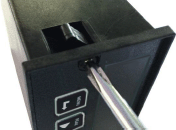 Slide the meter into a 45 x 92 mm 1/8 DIN panel cutout. Ensure that the provided gasket is in place between the front of the panel and the back of the meter bezel.
The meter is secured by two pawls, each held by a screw, as illustrated. Turning each screw counterclockwise extends the pawl outward from the case and behind the panel. Turning each screw clockwise further tightens it against the panel to secure the meter.
Slide the meter into a 45 x 92 mm 1/8 DIN panel cutout. Ensure that the provided gasket is in place between the front of the panel and the back of the meter bezel.
The meter is secured by two pawls, each held by a screw, as illustrated. Turning each screw counterclockwise extends the pawl outward from the case and behind the panel. Turning each screw clockwise further tightens it against the panel to secure the meter.
Turning each screw counterclockwise loosens the pawl and retracts it into its well. This position allows installed meter to be removed from their panel, or new meters to be installed in a panel. Do not remove the screws from their pawls. Doing so would cause the screw and pawl to fall off and likely get lost. Do not overtighten so as not to damage the plastic parts.
| Duty Cycle & Pulse Width Modulation (PWM) Modes | |
|---|---|
 |
In duty cycle mode, the meter displays ON or OFF time in percent from 0% to 100% of period for repetitive pulse trains. In the illustration, duty cycle in percent is 100 x t/P. In pulse width modulation (PWM) mode, the meter also determines the duty cycle ratio, but then scales this ratio for display in engineering units. |
| Monitoring Laser OperationPM and Speed | |
 |
Laureate counters can be programmed to display the duty cycle of a laser, the number of pulses, elapsed time, the number of pulses, the average pulse width in µs, and total energy applied. This data can be transmitted digitally via RS485 or Ethernet. |
IPC
Splashproof Cover
CLB01
RS232 Cable for Meters
CLB02
USB-to-RS232 Adapter Cable
CBL04
RS232 Cable for LT Transmitters
CLB05
USB Data Cable for Meters
CLB06
USB-to-RS485 Adapter Cable
CLB07
USB Programming & Data Cable
CLB08
RS485 Splitter Cable
BKBD
RS485 RJ11 Terminal Block Adapter
Understanding the Panel Meter for Duty Cycle and Pulse Width Modulation (PWM)
In electronics and industrial automation, precise measurement and real-time monitoring are critical for system efficiency and reliability. A Panel Meter for Duty Cycle and Pulse Width Modulation (PWM) is a specialized instrument designed to accurately measure and display the characteristics of PWM signals, which are integral to applications like motor control, power regulation, and signal modulation. This section explores the functionality, features, and applications of this essential tool.
What is a Panel Meter?
A Panel Meter is an electronic device that measures and displays electrical parameters, such as voltage, current, frequency, or, in this case, duty cycle and pulse width of PWM signals. Equipped with a digital display, it provides clear, precise readouts, enabling operators to monitor and control systems effectively. Available in various configurations, this meter is widely used in industrial settings for specific measurement needs.
Duty Cycle and PWM Basics
To understand the role of this Panel Meter, it’s important to grasp the concepts of duty cycle and PWM:
-
Duty Cycle: The duty cycle is the percentage of time a signal is active ("on") within a complete cycle. For example, a 25% duty cycle indicates the signal is active for 25% of the cycle and inactive for 75%.
-
Pulse Width Modulation (PWM): PWM is a technique that encodes information by varying the width of pulses in a signal. It is widely used to control motor speed, regulate power supplies, dim lights, and modulate signals, with its performance defined by frequency and duty cycle.
How Does a Panel Meter for Duty Cycle and PWM Work?
This Panel Meter is engineered to capture and analyze PWM signals, providing key measurements through the following process:
-
Measuring Duty Cycle: The meter calculates the time a PWM signal is high (active) versus low (inactive), expressing the duty cycle as a percentage to indicate the signal’s active duration per cycle.
-
Measuring Pulse Width: It measures the duration of high and low pulses, critical for fine-tuning PWM-controlled devices.
-
Frequency Measurement: Many models also measure the PWM signal’s frequency, which determines the cycle rate and impacts device performance.
-
Display and Output: Results are shown on a digital display, with options for alarms, relays, or communication interfaces (e.g., RS-485) to integrate with control systems.
Key Features
-
Accuracy: Delivers precise measurements of duty cycle, pulse width, and frequency for reliable control and troubleshooting.
-
Real-Time Monitoring: Provides continuous updates, enabling immediate adjustments to optimize system performance.
-
Compact Design: Typically in a 1/8 DIN size (96mm x 48mm), it fits easily into control panels with limited space.
-
Versatility: Supports a range of PWM applications, from motor control to signal analysis, adapting to diverse needs.
-
Programmable Options: Allows customization of display formats and measurement parameters for specific requirements.
Applications
The Panel Meter for duty cycle and PWM is used in various applications, including:
-
Motor Speed Control: Adjusts PWM signals to achieve precise motor speeds in industrial machinery.
-
Power Supply Regulation: Ensures stable voltage and current delivery in power supplies using PWM.
-
Signal Testing and Analysis: Verifies PWM signal performance in electronic circuits and devices.
Conclusion
A Panel Meter for duty cycle and pulse width modulation is an essential tool for managing PWM signals with precision. By offering accurate, real-time measurements of duty cycle, pulse width, and frequency, it supports effective control and monitoring in applications like motor speed regulation, power supply management, and signal analysis. Its versatility and reliability make it a critical component in enhancing system performance across various industries.
Where Is a Panel Meter for Duty Cycle and Pulse Width Modulation (PWM) Used?
A Panel Meter for Duty Cycle and Pulse Width Modulation (PWM) is a vital instrument in environments requiring precise measurement of PWM signals. Its ability to monitor and display duty cycle, pulse width, and frequency makes it indispensable for optimizing system performance in industrial, commercial, and research settings. Below are the primary industries and applications where this device is deployed.
1. Industrial Automation
In industrial automation, accurate control of PWM signals ensures efficient machinery operation. This Panel Meter is used to:
- Motor Control: Monitors and adjusts PWM signals to regulate motor speed and torque, critical for conveyor systems, robotic arms, and production lines.
- Process Control: Measures PWM signals for actuators and sensors, maintaining precise timing in automated processes like packaging or material handling.
2. Electronics Testing and Development
In electronics, this Panel Meter supports design and troubleshooting by analyzing PWM signals. Applications include:
- Signal Analysis: Verifies duty cycle and pulse width in circuit design, ensuring components operate correctly.
- Prototyping: Fine-tunes PWM signals during device development, ensuring performance and compatibility.
3. Communication Systems
In communication systems, PWM signals are used for modulation and signal integrity. This Panel Meter is applied in:
- Modulation Techniques: Measures PWM signals to ensure reliable data transmission in telecommunications.
- Signal Integrity: Monitors duty cycle and pulse width to prevent distortion or interference in signal processing.
4. Automotive Applications
In the automotive industry, PWM signals control critical systems. This Panel Meter supports:
- Engine Management: Adjusts PWM signals for fuel injectors and throttle actuators, optimizing engine performance and fuel efficiency.
- Lighting Control: Regulates PWM signals for LED lighting, ensuring consistent brightness and color in vehicle systems.
5. Consumer Electronics
In consumer electronics, PWM signals enhance device functionality. This Panel Meter is used in:
- Power Supplies: Tests and calibrates PWM-based power supplies for stable voltage and current output.
- Home Appliances: Monitors PWM signals in appliances like washing machines or refrigerators, ensuring efficient operation.
Conclusion
A Panel Meter for Duty Cycle and Pulse Width Modulation is a versatile and critical tool across industrial automation, electronics, communications, automotive, and consumer electronics applications. By providing precise measurements of PWM signal parameters, it ensures reliable system operation, enhances efficiency, and supports innovation. Its adaptability and accuracy make it an indispensable component in modern control and monitoring systems.
Less Information.








